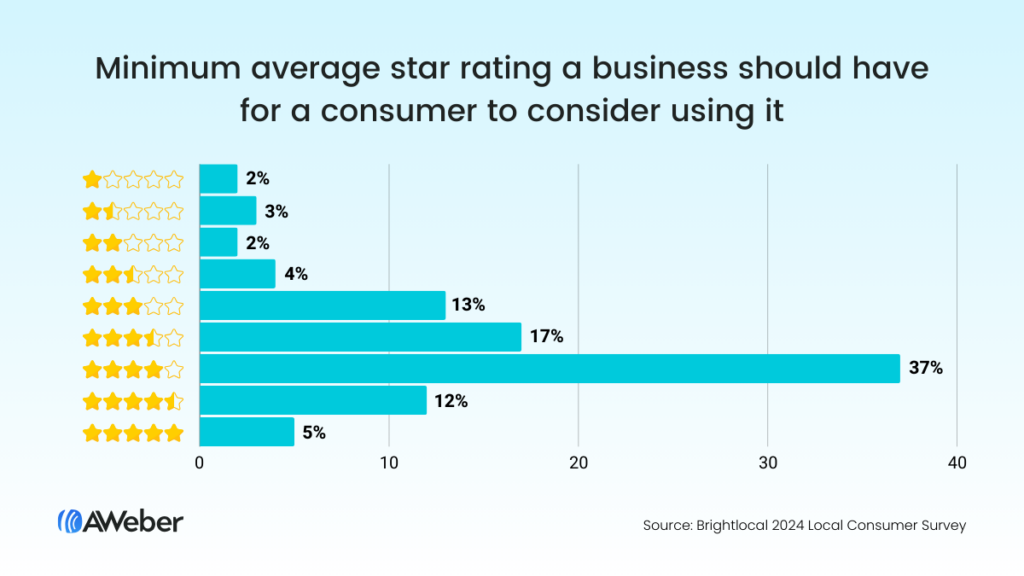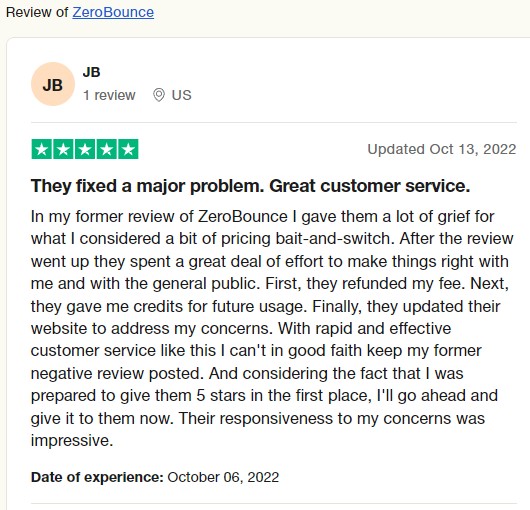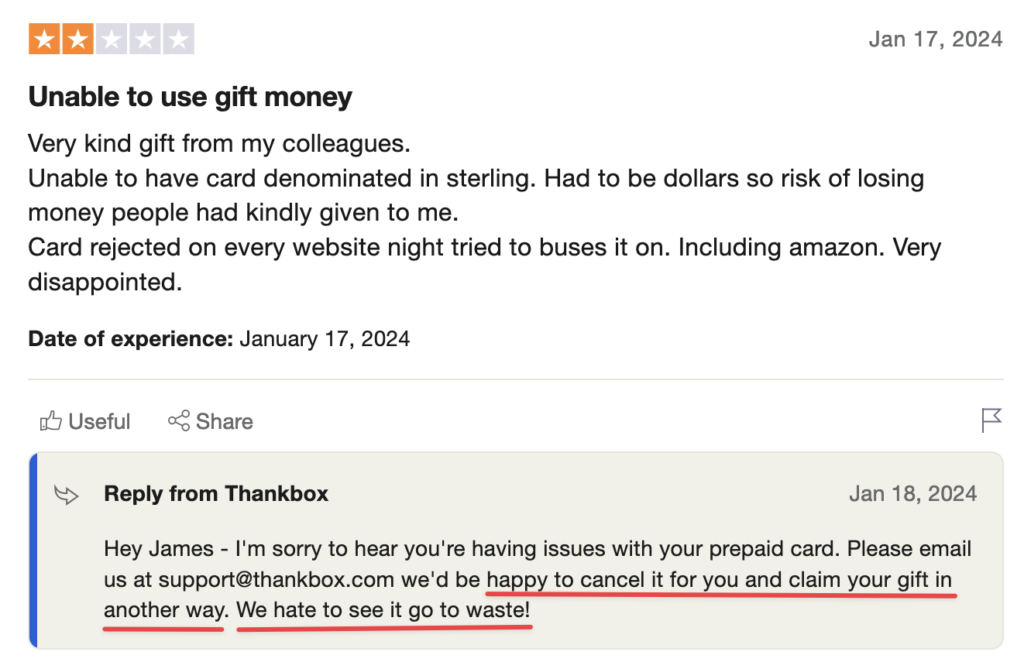How to respond to negative reviews online: Examples & 7-step template
By Rhonda Bradley April 25, 2024
If you’ve ever been surprised by a bad review of your business, you’re not alone.
Whether you run a local business, Etsy shop, YouTube channel, or other type of service that receives online reviews, we all have to face the dreaded bad review at some point.
Naturally, you want to ignore negative feedback, especially if it seems unfair or exceptionally harsh.
However, data shows consumers are 41% more likely to do business with companies that respond to all of their reviews, positive and negative.
I reached out to businesses with first-hand experience responding to bad reviews, and nearly every one of the 50+ people that shared their stories volunteered a common message: Bad reviews present valuable insights and opportunity for growth.
In this guide, you’ll find tips on the most pressing issues surrounding negative reviews, such as:
- How to write a productive response to nearly any type of bad review.
- Why it’s so tough not to take negative reviews personally.
- Why you should never delete or ignore bad reviews.
You’ll also enjoy stories and insights from businesses that have been where you are, and cheer for the CEO who used a surprise tactic to turn an irate reviewer into a customer evangelist.
How to respond to bad reviews
Are bad reviews good for business?
The psychology behind bad reviews
Why are people so harsh, and why does it get to me?
7 Steps to crafting successful responses to negative reviews
Tips, templates, and examples to help your team respond productively
3 Impressive review response stories with examples
Find out how three businesses turned things around after negative reviews
Are bad reviews good for business?
You wake up to discover that your 5-star status dropped thanks to a harsh negative review. It feels like personal criticism, and your natural reaction is to defend yourself by pointing out their inaccuracies.

But you can take heart in the fact that bad reviews, when handled professionally, can be very good for business.
For example, Laviet Joaquin, Head of Marketing at TP-Link, applies emotional intelligence when responding to poor reviews.

“When dealing with negative feedback, it’s not just a business issue. It’s a personal issue.
I’ve learned to separate my emotions from my actions and to focus on constructive solutions instead of negativity.
We’ve often restored their confidence and support by responding quickly and compassionately to their concerns.”
– Laviet Joaquin
The 3 Surprising Upsides of Negative Reviews
Negative reviews can humanize your business, legitimize your positive reviews, and boost your profits — provided you respond in a productive way.
1 – Responding to all reviews can result in a 41% boost in business.
Be warned, though, that ignoring reviews may have the opposite effect.
- A significant portion (41%) of consumers favor business that respond to all their reviews (positive and negative), however;
- Nearly half (47%) of consumers won’t take a chance on businesses that don’t respond to reviews.
2 – Negative reviews reveal opportunities for improvement.
Negative reviews provide you with valuable feedback that can help you identify areas for growth and improvement.
3 – Negative reviews humanize your brand.
Admitting your mistakes and empathizing with unhappy customers shows there are real people behind your brand who care about their experience.
4 – Negative reviews lend credibility to the review system.
Have you ever felt suspicious about a company or product that has nothing but 5-star reviews? It’s a little hard to believe, especially knowing how many less-than-honorable companies pay for fake reviews.
Negative reviews can serve as proof that your positive reviews are legitimate.
Jonathan Feniak, General Counsel at LLC Attorney, explains that, in the legal world, bad reviews are often simply part of doing business because “You can’t secure wins every time, which can make some clients very angry — even when your work went above and beyond.”

“The occasional bad review is expected, but it should be balanced with an overwhelmingly positive sentiment from most of your clients or customers.
At the same time, having perfect reviews looks even more suspicious to many people because it screams ‘reputation management’.
Deleting your negative reviews and other reputation management tactics can have the opposite effect and harm your credibility even more.”
– Jonathan Feniak
Many of the businesses you’ll read about below have used negative feedback to increase overall customer satisfaction, improve their products or services, and generate higher long-term profits.
However, overcoming bad reviews becomes tougher when your star rating dips below a four or five.
How bad is good? What consumers look for in starred ratings
Negative reviews can be good for business — but too many of them can put a serious dent in your profits.
Most consumers look for businesses with four- or five-star ratings. The majority (77%) of people will not do business with companies whose ratings are below three stars.
According to the Brightlocal 2024 local consumer survey, here are the lowest ratings consumers will accept when considering a business:

The psychology behind negative reviews
Bad reviews of your business, product, or service can be disappointing — and sometimes even emotional.
For example, small business owner and Reddit user grizzlygrizet was devastated by her first negative review, and internalized the comments as a gauge of her businesses’ quality.
“I just feel like a failure,” she explained, “as how else would we get such a rating?”

It’s normal to feel as if you’re on the other end of a gut punch when a bad review pops up, especially if you haven’t had much experience with negative reviews.
There are legitimate psychological and scientific reasons why unhappy customers often leave harsh reviews — and why it’s natural for you to sometimes feel hurt by them.

Why are unhappy customers so harsh in their reviews?
Negative emotions hit harder and last longer than positive ones. As a result, they need to be processed more thoroughly.
So when a customer has a bad experience with a business, writing a harsh review helps them overcome their uncomfortably strong emotional reaction.
On the opposite end of the spectrum, customers who’ve had a great experience tend to forget it more quickly. This is why it’s a great practice to encourage and ask for reviews on social media and in your email newsletters.
If negative reviews are good for business, why do they feel so hurtful?
Hurt feelings are a natural human response to negative feedback, which is why it’s easy to feel hurt over a bad review — even when it’s not personal.
Psychologically, this emotional human response is 100% normal. Psychologists and researchers say there are a couple of reasons we struggle when receiving negative feedback:
- By nature, negative feedback tends to cause feelings of shame. This is a natural human response to criticism because the brain often interprets negative feedback as a deviation from society’s standards.
- We humans often internalize negative feedback as a statement of our personal identity.
- Additionally, our brains often react to negative feedback as if it’s a threat that must be staved off.
The desire to react defensively is a normal human response that likely traces back to the beginning of time.
To overcome this natural reaction and respond productively, frame the feedback in a way that benefits you. Keep in mind that bad reviews can provide you with a type of insight, reflection, and clarity that you may never otherwise receive.

“Bad reviews helped me grow a thicker skin in every aspect of my life.
Criticisms are hard to face, especially when you aren’t expecting them. I learned to look at customer reviews like a public performance review – the feedback isn’t personal and can help me build a better business.
Bad reviews are always helpful even when they hurt because each one is an opportunity to learn and grow.”
Brooke Webber, Head of Marketing, Ninja Patches
7 Steps to crafting successful responses to negative reviews
How you respond to reviews will determine whether you win over new customers or send them running in the opposite direction.
Below is a 7-step process that will help you craft the perfect response to nearly any negative review.
#1 – Keep the end goal in mind
Maintain a calm and professional manner when writing your reply, even if the review is harsh or seems unfair.
Avoid any temptation to defend yourself or argue with reviewers.
If you feel attacked or angry, take a pause and remind yourself that bad reviews can ultimately boost your profits.
#2 – Respond quickly
Show that you take customer feedback seriously by responding quickly to negative reviews.
Reviewers want to see quick responses to negative feedback.
- 33% of consumers expect a response in 3 days or less
- 53% of consumers expect a response within one week.
Rex Huxford, Director of Demand Generation at MD Clarity, says that timely responses and resolutions make a strong statement about brand integrity.

“If we respond swiftly to negative reviews and find an adequate solution, that says far more about our brand’s values and priorities than anything we could write in an ad.
What matters most isn’t what businesses do in the best of times but how they react when things go “wrong” because every customer wants a guarantee that the money they invest in you is well-spent.”
– Rex Huxford
#3- Thank the reviewer and acknowledge their complaints
Start by thanking the reviewer for their feedback and acknowledging their poor experience.
Here are some examples:
- [Reviewer’s Name], thank you for sharing your feedback. We appreciate you taking the time to bring this to our attention.
- Hi [Reviewer’s Name], thank you for sharing your thoughts with us. We value your feedback and are grateful for the opportunity to improve.
- Thank you for bringing this to our attention [Reviewer’s Name]. Your insights are valuable as we strive to enhance our services.
#4 – Understand, empathize, and apologize
Next, show that you understand and empathize with their experience and apologize.
For example:
- We understand how [specific issue] can be frustrating. We’re here to help resolve this matter for you.
- Hi [Reviewer’s Name], we’re truly sorry to hear about your experience. Your feedback is invaluable to us, and we’re dedicated to making things right.
- We’re sorry you had a bad experience and assure you that we’re taking steps to prevent similar issues in the future.
Gauri Manglik, CEO and cofounder of Instrumentl, advises that acknowledging and apologizing shows you appreciate their input.

“One key strategy is to acknowledge the customer’s concerns and apologize for their negative experience.
This shows that you value their feedback and are committed to resolving any issues. Offering a solution or asking for more information can also demonstrate your willingness to address the problem.”
– Gauri Manglik
#5 Offer a resolution, possibly off-platform
To resolve their issue, you might need to take communication off the platform so that you can gather details, investigate, and offer a solution.
Here are some examples of how you can take the conversation off the platform:
- [Reviewer’s Name], we apologize for your experience and are committed to resolving this issue. Please reach out to [email/phone] so we can address your concerns personally.
- Hi [Reviewer’s Name], we understand your frustration and want to make things right. Please contact [Team Member’s Name] at [email/phone] so we can address your concerns promptly.
- Can you please provide more details with our (title) about your experience so we can address your concerns more effectively? Please reach out to [Team Member’s Name] at [email/phone] for further assistance with this matter.
In many cases, writing an apology email is the best way to address a problem. Other times, you may need to demonstrate your sincerity with compensation or proof that their feedback helped make changes to the way you do things.
#6 Close with appreciation and accountability
End your response on a positive note by showing appreciation and taking accountability for the customer’s poor experience.
Here are some examples of how to demonstrate appreciation and accountability:
- Providing excellent service is a top priority for our team. We appreciate your patience as we investigate this issue.
- We’re committed to providing a 5-star customer experience and appreciate your feedback in helping us achieve that goal.
- Thank you for your continued support and feedback. We’re committed to earning back your trust and confidence.
#7 Recognize the positive reviews, too!
Responding to positive reviews shows consumers that you appreciate their feedback and value their support.
Take the time to craft unique, personalized responses to all of your reviews — including the positive ones!
Examples of how businesses successfully respond to bad reviews
Three-quarters of businesses don’t respond to negative reviews, but many of the businesses that do respond swear by its results.
Zero Bounce, Capsule, and Thankbox share their experiences with bad reviews below.
Zero Bounce turns customer around with a whole-team effort
When a customer left a 2-star review and accused their company of “bait and switch,” due to an unclear pricing structure, the team at Zero Bounce didn’t take it lightly.
Instead, a team effort resulted in changes that prompted the reviewer to update to a 5-star rating.
ZeroBounce PR Manager Corina Leslie explains, “We all thought the pricing structure was clear on our platform, but this customer pinpointed that the copy was causing confusion.
Our whole team got to work right away to fix the copy, then I reached out to the customer via email and shared the updates.“
As a result, the customer updated her review to 5 stars and “is still a customer today,” according to Leslie.

Leslie praises the customer’s original review for allowing them to see things from the customer’s perspective.

“Whenever we get negative feedback, we get worried, but we never get mad.
Instead of getting defensive and trying to poke holes in their complaint, we try to fully understand why they said what they said – and put in the effort to resolve the issue.”
– Corina Leslie, PR Manager, Zerobounce
Capsule wins over unhappy reviewer with surprise tactic
Shortly after Capsule launched its public beta, a video creator wrote a negative review of the company in his newsletter.
Capsule’s response took the reviewer off-guard and turned him into a customer evangelist.
His surprise tactic: Agreeing with them!
“Hi! CEO of Capsule here. I read your review and while it wasn’t fun to read, I found myself agreeing with all your points.
It’s a tough call as a startup knowing when to push the “go” button. We chose to push it knowing that the product was far from perfect, but perhaps good enough that we could get some feedback.. Even if that meant some of it would be negative.
Thanks for writing, hope you’ll give us another shot soon!! We’ll be pushing fixes and features like mad 😉 “ – response written by Capsule CEO Champ Bennett
The reviewer, Video creator Tiger Joseph, was so impressed with CEO Champ Bennett’s response that he shared it on LinkedIn under the title “Quick story on humility for any CEO…”
“…Talk about a winning attitude.
If you can take harsh feedback & transform it into positive change, you have a RARE superpower.
I already have high hopes for Capsule’s future from this short response.”


“While negative reviews don’t ever feel good, they often signal something very valuable: that people care enough about your product to:
1) have an opinion about it and
2) take time to let you know where their expectations fell short.”
– Natalie Taylor, Head of Marketing, Capsule
Thankbox CEO uncovers the benefits of consistent professional responses
Valentin Hinov, CEO and founder of Thankbox, says that the true benefit of responding to negative reviews is showing potential customers that you care about their experience.
“During the first year or two of my business,” he explains, “when I got bad reviews, I took them personally and did everything I could to appease the reviewer to get them to update their review.”
But Valentin says that one of his most important lessons was learning not to expect reviewers to update their public feedback, even after you help them.

“Negative review replies are for the benefit of your future customers, not the reviewer.
While you should be respectful and aim your answer at the reviewer, think about others who will be reading your reply and judging your business on it.
Your future customers want to see that you’ve handled the situation correctly and that there’s a solution should they also find themselves needing support.”
– Valentin Hinov, CEO & Founder, Thankbox

Writing productive responses to bad reviews
Regardless of your industry or company size, responding professionally to all your reviews (negative and positive) can improve your product, customer experience, and overall profits.
Here’s a bonus tip to help improve your review ratings:
Nurture relationships with customers in-between purchases by sending out a personalized weekly newsletter. Well-written, non-promotional newsletters can humanize your brand and encourage positive sentiment when people are writing reviews.
To get started with personalized email nurture campaigns, visit AWeber and sign up for a free account today.
 87% off ends soon!
87% off ends soon! 
